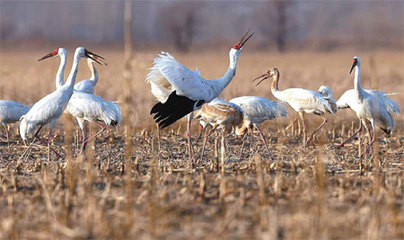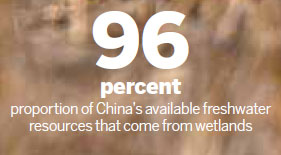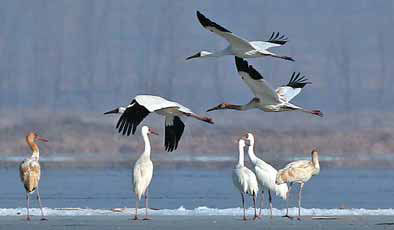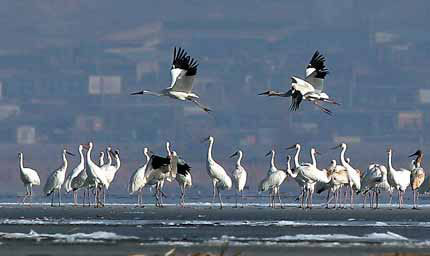White Crane dance takes flight
Updated: 2014-04-03 07:34
By Gao Anming, He Na and Wu Yong (China Daily USA)
|
||||||||
Combination of movements also forms a good basis for daily exercise, Gao Anming, He Na and Wu Yong report in Shenyang.
A new dance craze has been sweeping Faku county in Liaoning province. Like the traditional dances performed by generations of locals through the ages, the White Crane, which mimics the movements of the majestic bird for which it's named, is based on the natural world.
The dance, invented by Meng Xiangtai, a professor at Shenyang Sport University, has enjoyed huge popularity since it was unveiled in May, but it also forms a series of daily exercises.
Based on Meng's long-term, detailed observations of white cranes - an endangered species that has the same level of protection as the Siberian tiger and the panda - the dance involves 44 separate movements. Its popularity is partly due to the fact that it's easy to learn and promotes good health, but more important, it reflects the local people's love of white cranes.
Faku is home to Huanzidong National Wetland Park, which lies along an important migratory corridor in northeastern Asia. Every year during spring and autumn, the two migratory seasons, Huanzidong welcomes about 3,000 rare birds - including about 2,000 white cranes - which land to recharge their batteries, staying for 90 to 100 days.
The local government's wetland protection measures have been so successful that the number of migratory birds, especially white cranes, has remained stable during recent years, and Faku has been honored as "China's White Crane County", a name bestowed by the China Wildlife Conservation Association.
Every year, the white cranes migrate twice. They make a round trip, flying from Poyang Lake, China's biggest freshwater body, in Jiangxi province, to Siberia, a journey of 5,000 kilometers each way.
As one of the major stopover points, the dish-shaped wetland with its abundant flora provides a natural nesting place and shelter.
According to statistics from the CWCA, the global population of white cranes is about 3,000, and Huanzidong hosts more than 2,000 every day during the migratory seasons, accounting for about 70 percent of the total.
The rare birds also attract ornithologists and experts from across the world who regard the gathering as a sort of miracle.
White cranes have an almost entirely snowy plumage, orange beaks and red feet. They have a strong attachment to the wetland because the birds rely on insects, fish, seeds, and the roots of water plants for food.
The perfect environment
With a total coverage of 2,300 hectares and water coverage of 1,800 hectares, Huanzidong is much smaller than other wetlands across the world, such as the Pantanal Matogrossense National Park in Brazil, the Isimangaliso Wetlands Park in South Africa, and the Momoge Wetland in China's Jilin province.
"The experts say that having so many birds gathered in such a relatively small area provides the perfect environment for bird-watching," said Feng Shouquan, secretary of the Faku county Party committee.
Every spring and autumn, Huanzidong is paradise for the birds. The blue skies are decorated with white clouds, the clear water stretches seemingly endlessly, and the wetland banks are overgrown with reeds in which white cranes shelter or soar high above on outstretched wings.
According to Party secretary Feng, in addition to the white cranes, about 190 species of bird are known to nest and breed in Huanzidong, and 27 of them - including hooded cranes, red-crowned cranes, Oriental white storks and highland guans - are on the national level protection list.
"We have worked out strict regulations to protect Huanzidong and build it into an important international wetland. We also plan to return some 1,300 hectares of farmland surrounding Huanzidong to wetland and make the park a well-facilitated tourist resort to promote environmental protection, education and entertainment within five years," Feng said.
"A good environment and large numbers of birds will result in more visitors and indirectly promote tourism and our economy to benefit local people," he added.
Chen Mingzhong, director of the Faku Forest Bureau, said: "We have strengthened our crackdown on behavior that is harmful to the birds and the wetland. In addition to supervision from the forest police, we have also employed staff to patrol the region every day. Farmers in the surrounding villagers established a voluntary bird and wetlands protection association, which has played an important role in protecting the environment during recent years."
Zhenzijie village resident Wang Zhenyou is one of the farmers in question. The self-confessed bird lover first volunteered to protect the avian visitors in the 1980s.
"In the 1980s, the area of wetland was much bigger than it is now. When you stood near the bank in the migratory season, the white cranes would stand on your arms to eat the corn seeds you held in your hands," recalled the 75-year-old.
"Our association has 22 people now. The patrol region is huge, but for the sake of the birds, we all volunteered to help. In the early years, my family didn't understand me, but now they are all very supportive. Several years ago, we regularly found birds trapped in the reeds and often caught people who hunted them illegally. Thanks to the movement to raise protection awareness, we see a lot less illegal behavior nowadays," he added.

After spending almost three decades observing the birds, Wang Zhenyou is something of an expert and is often consulted by staff from the local forestry bureau. He keeps a diary in which he details the birds' movements and always has firsthand data relating to their arrival and departure.
Faku holds a white crane festival every year. This year it began on March 30 and will run until the middle of May. When he's not on patrol, Wang volunteers to guide visitors around the wetland.
"I know where the birds nest and can help the visitors save valuable time. I also remind them not to disturb the birds. I am very proud to live here," he said.
Qian Fawen, an ornithological expert from the China Academy of Forestry, confirmed the importance of protecting the white cranes. "They only hunt in shallow water, so controlling and providing a suitable water level is vital to their survival," Qian said.
Wetland protection
"To protect the wetlands scientifically, we invited some well-known experts to come and brainstorm. They made some good suggestions," Party secretary Feng said.
Often called the kidneys and lungs of the earth, China's wetlands are fundamental to the country's water resources. They feed downstream waters, trap floodwater, recharge the supply of groundwater, remove pollution, and provide a habitat for fish and wildlife. The wetlands also have an economic function through their role in sectors such as fishing, hunting, agriculture and recreation.
In January, the State Forestry Administration released the Second National Wetlands Recourses Census. The comprehensive five-year survey shows that China has 53.6 million hectares of wetland, accounting for 5.58 percent of the country's territory.
According to Zhang Yongli, deputy director of the administration, 96 percent of China's available freshwater resources come from wetlands, which also play an important role in combating climate change and provide a habitat for 2,312 kinds of vertebrates, including 231 bird species, and are also home to around 4,220 plant varieties.
The survey shows that China has 577 natural preserves and 468 wetland parks, and that the area under protection has increased by 5.26 million hectares from 23.24 million hectares compared with 2009.
Despite the increase, there is no real cause for optimism, according to Zhang: "Wetlands coverage has fallen by 3 million hectares during the past decade, and the destruction caused by humans is the main cause. China's wetlands still face many problems, including the reduction of coverage, function degradation and a lack of protection. More importantly, nationwide protection regulations and a long-term protection mechanism have yet to be established. All of this has hindered our progress in terms of protecting the wetlands. Technological support is also very weak and public awareness of protection needs to improve."
Zhang's view was echoed by Zhou Jingbo, an associate professor at Renmin University's School of Environment and Natural Resources, who said: "Protection of wetlands revolves around solving the problems arising from the relationship between protection and rational use. We must accelerate the process of establishing protection laws and regulations to clearly define the layout, treatment and development. We must take protection out of the hands of the State Forestry Administration and establish a long-term management mechanism that involves a number of government departments and institutes," he said.
For Zhang, the solution is simple: "We must ensure that the coverage of China's wetlands is no less than 53.33 million hectares by 2020, and defend them resolutely."
Liu Ce contributed to this story.
|
White cranes gather in a wetland in Faku county, Liaoning province. Zou Hong / China Daily |

|
White cranes (top and above) during their stay in Huanzidong, Liaoning province. Photos by Zou Hong / China Daily |



(China Daily USA 04/03/2014 page7)
Most Viewed
Editor's Picks

|

|

|

|

|

|
Today's Top News
Shooting reported at US Army base in Texas
Asiana admits pilot error in crash
Sina Weibo picks Nasdaq for IPO
Chinese tourist abducted in Malaysia
Japan removes export ban on military goods
5 dead in 8.2 quake off Chile
NY Councilman meets 'the press'
MH370 'unlikely' to hurt ties
US Weekly

|

|

















